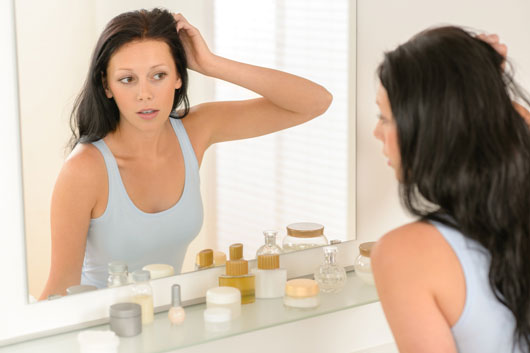
Dying hair is a fabulous yet simple way to freshen up your look for spring and it doesn’t involve dieting or sweating it out at the gym. Whether you just want to amp up your natural hue or make a total transformation à la Kim Kardashian‘s platinum ‘do at Paris Fashion Week (We don’t recommend anything that drastic!), it’s never been easier to achieve great results with at-home color.
The right hair coloring gives your strands depth and vibrance. It can brighten your complexion, make you look younger and revitalize your whole outlook. If dying hair is a brand new experience for you these tips are the perfect starting point and if you’re an at-home hair coloring master, you may just learn a thing or two. So here are 10 things you need to know about dying hair.
1. Choose Your Shade
Experts recommend that you not go more than two shades lighter or darker than your natural color. Keep in mind that it’s much easier to darken a shade that’s too light than lighten a too-dark color. Just like makeup, it’s important to choose a hue that complements your complexion. For the most natural results Jennifer Aniston’s colorist Negin Zand advises, “The fine hair there grabs onto the color and tends to get dark faster. I always use a color that’s two shades lighter than the one I’m using for the back of the head at the hairline, from ear to ear. That keeps it from looking obviously dyed, and it’s much more natural and youthful.”
Read Related: When Should You Let Your Hair Go Gray?

2. Choose Your Formula
There are plenty of different types of hair dye to choose from. Mousse is easy to work with and won’t drip. Semi-Permanent color is easier on your hair and washes out gradually so you won’t have a sharp line of new growth. Glaze doesn’t change the color, it just adds dimension and shine.
3. Get the Right Tools
Keep Vaseline and Q-tips on hand to clean up any color that drips on your skin—you want to get it right away before it stains. Most at-home hair color comes with an applicator bottle and occasionally a highlighting brush but it’s well worth it to go to a beauty supply store and get a stiff tint brush and a slant-tip applicator bottle so you can get each strand.

4. Don’t Pre-Wash
Believe it or not, it’s best to color unwashed hair. Your natural oils will protect your scalp from the chemicals.
5. Do it During Business Hours
Especially if it’s your first time, it’s a good idea to embark on your hair dying odyssey at a time when you can call the 800 number on the box if you run into a problem.

6. Highlights
Highlights really are best left to the pros. Really good highlights look natural as they grow out so you will only need to visit the salon every three months or so.
7. Root Touch-Up
To extend the time between colorings, use a root touch-up like ColorWow brush-up or Rita Hazan Root Concealer spray. Both products instantly cover roots and stay on until you shampoo.

8. Color on Color
If your hair is already colored or processed in some way, it’s best to go to a salon. They’ll know how to avoid damage and unexpected color variations. Often processed hair reacts differently than ‘virgin’ hair.
9. Protect
Protect your color and your locks post-dye by using shampoos and conditioners formulated for colored hair. Dying your hair, especially if you go lighter, can be damaging so use a hydrating hair mask regularly. Avoid sun and chlorine, which can fade color, dry out your hair. Chlorine can also give blonde shades a greenish tinge.











